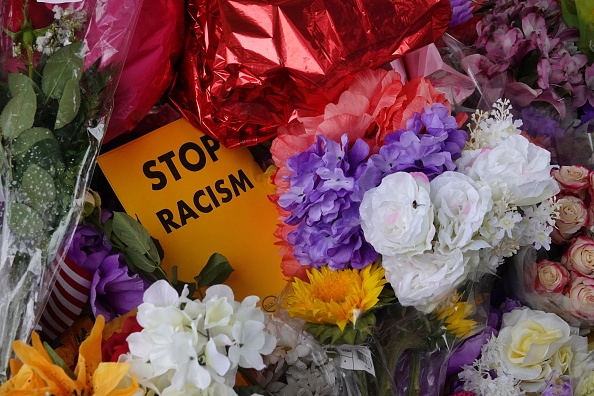Resources for Reporters and Editors Covering the Shooting in Buffalo

Flowers, candles and mementoes are left at a makeshift memorial outside the Tops market on May 18, 2022 in Buffalo, New York. A gunman opened fire at the store on Saturday, killing 10 people and wounding three others. Police say it's being investigated as a racially motivated hate crime.
On May 14th, 10 people were killed after an 18 year-old white supremacist gunman opened fire in a supermarket located in a predominantly Black neighborhood in Buffalo.
As the country, and community, grieve one of the deadliest racially-motivated mass shootings in recent history, the Dart Center has gathered a selection of resources to support journalists as they cover the tragedy and its aftermath.
Traumatic Imagery
Newsrooms will be working through trauma-related imagery. Best practice on the safe handling of such material can be found here in the form of a short introduction and a full manual.
In recent years, videos of the killings of Black citizens by police and in racist attacks have sparked sweeping protests. But the ongoing flood of shocking videos also has other consequences, especially for communities of color. Here, academic Emily Bernard and journalist (and incoming Dean of Columbia Journalism School) Jelani Cobb discuss how journalists can balance urgent news value against sensationalism and trauma.
Advice for Managers and Editors
A collaboration between ACOS Alliance and Dart Centre Asia Pacific, this guide is designed to help editors and managers understand and support their teams. It is divided into five sections covering both general information and specific suggestions and tips for working with freelancers.
These tips for managers and editors help them prepare and support reporters in the field.
This Trauma and Journalism handbook distills the expertise of international trauma experts.
This six-part podcast series from the International Journalists’ Network featues interviews with reporters and mental health experts.
Interviewing and Reporting
In this guide journalists, researchers and mental health professionals offer advice on how to working with victims and survivors of traumatic events
"Best Practices in Trauma Reporting" was drawn from a decade of Dart Award-winning stories.
The Dart Centre Style Guide is designed as a quick, authoritative reference for reporters, editors and producers working on tight deadlines. It includes brief evidence-informed guidance on news choices, language usage and ethics in reporting on the impact of trauma on individuals, families and communities; recommendations for appropriate use of relevant psychological and scientific terminology; and special considerations when reporting on consequential trauma-laden issues.
There is no infallible method for interviewing survivors and witnesses to trauma. Each case is unique and presents its own challenges. But this tip sheet brings together the collective experience of the Dart Centre Asia Pacific’s principal trainers to provide some general advice for interviewing in the aftermath of trauma, and recommendations for before, during, and after the interview.
Mexican journalist Marcela Turati has reported on different types of violence for 12 years. These tips are drawn from her workshop How to Cover Pain, and can be used as a roadmap to conduct a humane, sensitive, and respectful interview.
In this talk, Kate Porterfield, consulting clinical psychologist at the Bellevue Hospital Program for Survivors of Torture in New York City, talks through clinical techniques that journalists can draw upon when interviewing survivors of trauma.
Covering guns and gun violence
This resource offers a compilation of journalist-to-journalist advice, from those who have covered large-scale shootings.
Here, Psychiatrist Frank Ochberg, M.D. and Bruce Shapiro, executive director of the Dart Center, share insights on covering mass killings in the aftermath of the 2011 Arizona shooting that left six dead and a U.S. Congresswoman grievously injured.
Based on guidance from the families of mass shooting victims, this resource focused on how the media can limit use of shooters' names.
The reporter Dave Cullen's lessons from a decade of reporting on the Columbine attacks.
Self-care
This self-directed course on Poynter will teach you how traumatic stress affects victims, how to interview trauma victims with compassion and respect, and how to take care of your own health after covering a traumatic event.
From Black Lives Matter to #MeToo, many reporters feel emotional distress covering the violence and abuse their communities face. Here are expert tips on how to navigate that stress.
A guide for journalists seeking therapy for personal or work-related issues.
The Journalist Trauma Support Network is a pilot program training therapists to help journalists.
The U.S. Journalism Emergency Fund and Black Journalists Therapy Relief Fund is a joint effort from the International Women’s Media Foundation and the Black Journalists Therapy Relief Fund to provide emergency funding to Black journalists.
































































































